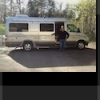Winterized again: I love my RV's Webasto heater
I am a huge fan of the Webasto Dual Top RHA 100 diesel-powered combined air and water heater for the Roadtrek eTrek and, as an option, on other Roadtrek models.
In terms of heat, it both heats up the inside of the coach and provides hot domestic water. The entire unit fits under the vehicle chassis, saving precious space inside. A small fuel line runs under the coach from the Mercedes engine up front to the Dual Top, mounted under the rear of the vehicle. Heat is pushed out through two air outlets. In my unit, they are directly beneath the rear sofa. When we make it into a bed, it’s like having heated sheets. The domestic water boiler on the Dual Top is connected directly to the fresh water tank and the hot water faucets. And it is whisper quiet. Though mounted underneath the sleeping area on the underside of the coach, a muffler connects to an outside exhaust pipe and, really, we don’t even hear it.
Here’s a detailed description from Webasto on how the Dual Top works:
When the unit is switched on the dosing pump feeds fuel from the vehicle’s fuel tank to the heater. Here the fuel is automatically ignited by means of a glow plug. If combustion does not occur immediately the unit automatically repeats the start-up procedure. In the combustion chamber a flame is lit which heats up the heat exchanger. The unit takes air in from outside of the vehicle for combustion purposes and the combusted exhaust air is discharged back outside. During heating, the integrated fan sucks in the air to be heated through the inlet and feeds it through the unit. As the air flows through the heat exchanger it is heated up and is then distributed through the outlet.
The connected hot air ducting spreads the air evenly throughout the vehicle interior. Due to the unit’s separation of the combustion cycle from the heating cycle there is no quality impairment of the hot air. A temperature sensor constantly measures the interior temperature and adapts the heating level by automatically adjusting the amount of air passing through the unit. In this way, the temperature selected by the user is rapidly reached and maintained at a constant level. After the unit has been switched off, the combustion process is terminated in a controlled manner. For this purpose the unit briefly goes into re-run mode to cool itself down. It is then immediately ready for restarting.
I really came to appreciate the Dual Top on my return from sunny Florida to frigid Michigan. On the way back north, we overnighted near Lexington, KY in mid-January. The heater is quiet and kept us toasty warm at 70 degrees despite a plunging temperature outside.
I got worried the next morning when I saw ice caked on the underside of the heater. Oh oh, I thought.
Instead of a problem, it was a very cool feature (pun intended) of the heater. It was protecting itself against the cold. The Dual Top is automatically programmed to empty its water supply if the temperature drops lower than 43 degrees Fahrenheit. It does that, by the way, even if it is off. That night in Lexington, it got down to 26.
I had emptied the water from the fresh water tank and ran the inside faucets dry back in Georgia. But I still needed to get antifreeze into the eTrek. I stopped at one big RV dealer in Ohio and they weren’t very interested in helping as they were unfamiliar with the eTrek.
So I drove home, where the thermometer dropped to three below zero overnight. I kept the Webasto heater running with forced air all night. The next day, I got it to my local Roadtrek dealer.
There, sure enough, we found the water pipes frozen. In a heated garage, we waited for them to defrost. I cranked the Webasto up to help further warm the interior and, after a couple hours, we were able to get antifreeze through the system. Fortunately, there were no leaks. If the heater hadn’t kept the inside warm all night long, I’m sure those pipes would have burst.
As it was, it is a reminder not to take anything for granted with the weather. I should have winterized in Georgia.
But the incident has made me very appreciative of an excellent heater.
All said, though, I’d rather be in Florida.




0 Comments
Recommended Comments
There are no comments to display.
Please sign in to comment
You will be able to leave a comment after signing in
Sign In Now